
China’s increasing economic and strategic footprint in South Asia poses a challenge to India’s own sense of influence in the region and its efforts to maneuver its strategic aims alongside a growing China-Pakistan nexus. While the United States and India have found a broad strategic convergence in terms of managing the rise of China in the Indo-Pacific region, the devil is in the details. The United States is proactive in protesting China’s aggressiveness in the South and East China Seas, but it has been relatively lukewarm in its response to China’s activities in South Asia, including the China-Pakistan Economic Corridor (CPEC), which India sees as an infringement on its territorial sovereignty. While the India-United States partnership will continue to feature prominently in the strategic calculations of both countries, New Delhi needs to be pragmatic about what it can and cannot expect from Washington.
China’s South Asia Strategy
Chinese involvement in India’s neighborhood, whether it is fairly recent such as in Bangladesh or Sri Lanka or more long-term like its partnership with Pakistan, is aimed at checking India’s influence in the region. Many Indian foreign policy experts view China’s “commercial activities” in India’s neighborhood as a means of strategic encirclement. China has certainly been showcasing its ability to pursue outcomes in the region that are favorable to its interests with initiatives like the ambitious One Belt, One Road Strategy (OBOR) (now called Belt and Road Initiative). India has struggled to counter Chinese moves in South Asia because many South Asian countries believe that good ties with China will balance out India’s dominant position in the region.
In response, New Delhi is looking to Southeast Asian markets and energy-rich Central Asian countries to support its economic growth and is developing robust defense partnerships with the likes of Vietnam and Singapore. But China views these regions as falling in its sphere of influence and will protect its ability to project hard and soft power there. Neither would like to concede this space.
To make matters worse, the United States sees its South Asia policy largely through the prism of its Afghanistan strategy, leaving India alone to deal with China’s incremental but unmistakable lateral expansion into South Asia. U.S.-engineered connectivity projects in Asia such as the New Silk Road Strategy and the Indo-Pacific Economic Corridor are still pipe dreams compared to the kind of diplomatic consensus that China was able to generate through the Belt and Road Forum (BRF) this year. India boycotted the BRF to demonstrate its objection to CPEC, which is an important part of OBOR. On the other hand, the Trump administration, as a part of its trade deal with China, recognized China’s OBOR strategy and sent National Security Council official Matthew Pottinger to attend the BRF in China.

Testing the Limits of India-United States Ties
The United States’ approach to China’s role in South Asia is a critical node of the Washington-New Delhi partnership, which should be soberly assessed. Afghanistan appears to be one point at which U.S. interests may diverge with India’s. It seems plausible that President Trump’s decision to halt nation-building and enhance counterterrorism efforts in the ongoing war in Afghanistan could create space for U.S. accommodation of Chinese presence in South Asia. There seems to be at least some indication that the United States might consider a larger Chinese role in Afghanistan.
Given that the strategic rationale for the India-United States partnership in the Indo-Pacific continues to be largely framed in terms of managing China’s rise, it is significant to note that the Trump administration remained relatively quiet during the Doklam standoff. This could be explained as Trump’s choice to refrain from disturbing its relationship with China at a time when Washington seems to be looking towards Beijing to help deal with North Korea’s belligerent behavior. However, such an approach also reflects the need to be mindful of the limits of the ties between India and the United States when it comes to operationalizing their strategic convergence.
Build Partnerships, Don’t Depend on Them
Though the present formulation of the India-United States strategic partnership aims to counteract the rise of an aggressive China in the Indo-Pacific region, it should be assessed in light of the changing power dynamics between the United States and China. The intersecting geopolitical and geoeconomic spaces of India and China create opportunities for economic engagement while providing recipes for strategic competition, as in the Doklam standoff. However, if strategic harmony were to arise between Beijing and Washington, a scenario could transpire in which the United States could be a silent spectator during a period of crisis in South Asia as long as its interests are not directly harmed. Ultimately, the potential for the United States to be vocal against China in any future moments of strained Sino-Indian relations will be determined by the evolving nature of the great power relationship between the United States and China.
***
Image 1: Via Narendra Modi Flickr (cropped)


